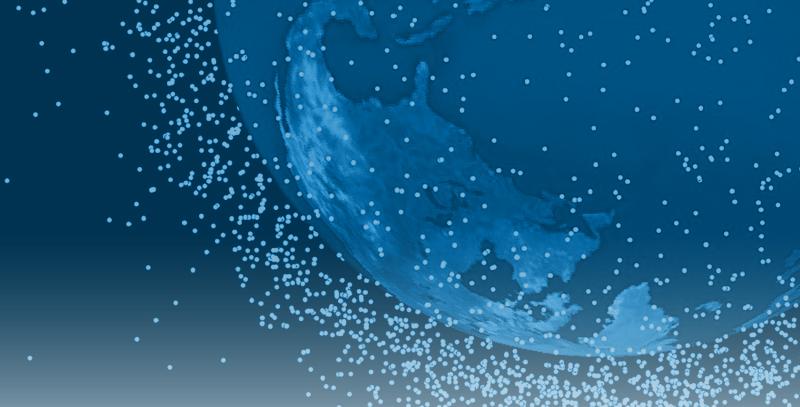LEO stands for low Earth orbit and is the region of space within 2,000 km of the Earth’s surface. It is the most concentrated area for orbital debris.
This computer generated image (at right) shows objects in Earth orbit that are currently being tracked. Approximately 95 percent of the objects in this illustration are orbital debris, i.e., not functional satellites. The dots represent the current location of each item. The orbital debris dots are scaled according to the image size of the graphic to optimise their visibility and are not scaled to Earth.
As if we’re not chucking enough rubbish across the earth, NASA estimates there are more than half a million bits of debris or ‘space junk’ orbitting the Earth. Not all items are man-made but, of course, way too much is.
Space debris is made up of natural (meteoroid) and man-made particles but while the former bits are orbiting the sun, the latter is orbiting the Earth. This is Orbital Debris, the Space Junk, which includes nonfunctional spacecraft, abandoned launch vehicle stages, mission-related debris and fragmentation debris.
There are more than 20,000 pieces of debris larger than a softball orbiting the Earth. They travel at speeds up to 17,500 mph, fast enough for a relatively small piece of orbital debris to damage a satellite or a spacecraft. There are 500,000 pieces of debris the size of a marble or larger. There are many millions of pieces of debris that are so small they can’t be tracked.
Even tiny paint flecks can damage a spacecraft when traveling at these velocities. In fact a number of space shuttle windows have been replaced because of damage caused by material that was analyzed and shown to be paint flecks.
With so much orbital debris, there have been surprisingly few disastrous collisions.
In 1996, a French satellite was hit and damaged by debris from a French rocket that had exploded a decade earlier.
On Feb. 10, 2009, a defunct Russian satellite collided with and destroyed a functioning U.S. Iridium commercial satellite. The collision added more than 2,000 pieces of trackable debris to the inventory of space junk.
China’s 2007 anti-satellite test, which used a missile to destroy an old weather satellite, added more than 3,000 pieces to the debris problem.
Tracking Debris
The Department of Defense maintains a highly accurate satellite catalog on objects in Earth orbit that are larger than a softball.
NASA and the DoD cooperate and share responsibilities for characterizing the satellite (including orbital debris) environment. DoD’s Space Surveillance Network tracks discrete objects as small as five centimetres in diameter in low Earth orbit and about one metre in geosynchronous orbit. Currently, about 15,000 officially cataloged objects are still in orbit. The total number of tracked objects exceeds 21,000. Using special ground-based sensors and inspections of returned satellite surfaces, NASA statistically determines the extent of the population for objects less than ten centimetres in diameter.
Collision risks are divided into three categories depending upon size of threat. For objects ten centimetres and larger, conjunction assessments and collision avoidance manoeuvers are effective in countering objects which can be tracked by the Space Surveillance Network. Objects smaller than this usually are too small to track and too large to shield against. Debris shields can be effective in withstanding impacts of particles smaller than one centimetre. You can find out more about space junk HERE






